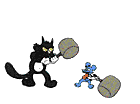Rolls (Exercise 20 on page 29)
E: the tutor shows a bottom D gracenote separating the second two notes. Since E is (at this point in the tutor) is always played with the chanter closed on the leg, does this mean that the chanter is actually closed, so no sound comes out? Or is it a one finger tap to ghost D? Or is the chanter actually quickly lifted and lowered off of the leg to hear a real (though very rapid) bottom D?
F-sharp: the tutor shows an E gracenote separating the second two notes. To play this, do I very rapidly switch the bottom hand to an E and then back to an F-sharp? Do I just tap the middle finger, closing the chanter and momentarily stopping the sound?
G: Makes sense.
A: Similar to the questions on E and F-sharp, the tutor shows an G gracenote separating the second two notes. To play this, so I very rapidly switch the fingers to a G and then back to an G? Do I just tap the top ring finger, closing the chanter and momentarily stopping the sound?
The Highland Piper in me wants these gracenotes to be quick, one-finger motions, but it the written gracenotes are to be heard, that cannot be the case--unless the notes written are meant to say "close the chanter and stop the sound"
* * * * * *
High E-gracenote from back D? The tune The South Wind has on two occasions an high E-gracenote from back D. Short of playing a real, though short high E, I can't figure out how to make that work...
* * * * * *
Triplets (Lesson 12 on page 31)
In Garrett Barry's Jig, there are many triplets, as this embellishment has just been discussed.
In bar 3, the is a D C A triplet. The tune in question is in G, so the C is a C-natural. For this triplet, does one quickly pop out a C-natural (lifting both top index finger and bottom middle finger), or since it is such a quick movement, does one just use a single finger (top index finger in this case) and have a brief C-sharp? It is worth noting that the C-sharp has not yet been learned in this tutor.
In bar 4, the is a second octave G F-sharp E triplet. The question again, is how true are these triplet notes tot he real fingerings of the notes? She discusses the high G, and how it is played with only one finger raised, but fails to discuss other notes. Is the E played by lifting both the ring finger and pinkie, or just the ring finger?
* * * * * *
Thanks in advance for all that take the time to answer these questions. I look forward to having this stuff cleared up!
Matt Willis
http://www.mattpiper.com
Piper with The Killdares
